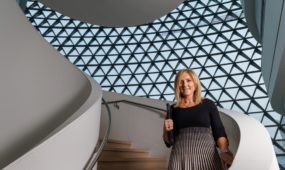Makers Empire pushes in to Empire State schools
Education
DEVELOPING an educational app to take advantage of the latest 3D printing technologies took years of experience and understanding how kids played and interacted with video games.

Sign up to receive notifications about new stories in this category.
Thank you for subscribing to story notifications.
It started when game developer Roland Peddie was working in Scotland on video games, winning a BAFTA for his work on bestseller Crackdown at Realtime Worlds in 2007. During work on a following project, APB, he noticed that a lot of players spent as much time customising their character as actually playing the game.
Peddie brought that insight back to his hometown of Adelaide, South Australia and started working on apps that let the user customise and build their own things, whatever they were.
At the end of last year he teamed up with Jon Soong to make a prototype and commercialise it. Makers Empire was born.
It's a simple, module-based app aimed at Primary School students, according to Soong, now the CEO of the company. The children draw outlines, drag shapes and stick bits together on an iPad to create a 3D model – and then they can make it real.
The company timed the launch just right. 3D printing has entered the common vocabulary and the cost of entry drops every day – though it's still a little “do-it-yourselfy,” Soong admits.
More importantly, building things is at the front of youngster's minds with the astonishing rise of creative games like Minecraft. Even more than the glory days of Lego, kids are accustomed to shaping and building the world around them, and increasingly doing so in the digital space.
“We went round to a bunch of different primary schools and ran classes to find out what the teachers thought and how the kids reacted,” Soong says.
Makers Empire brought in educators to help them align the app around curriculum and learning outcomes for students.
“In primary schools, there's no way you can just hand them a bit of software and have them use it, because a primary teacher has to teach eight subjects. In high school a design and tech teacher can learn one thing really well, but primary teachers don't have that luxury.”
The company’s marketing director, Lap Leung, has a video of himself at a school, standing at the front of a class and shouting: “Are you ready for 3D printing?!”
The kids shout back in excitement. Moments later they're doodling designs and making shapes in the app, then watching their creations come together in a 3D printer.
“We have lesson plans, each one outlines the learning outcomes, assessment and so forth. Then at the end we reference the curriculum it's aligned to,” Leung explains, adding that a teacher's portal lets teachers quickly assess a whole class' work.
Soong, having completed his honours in computer science, knows it can be hard to make the topic exciting.
“Learning algorithms is pretty dry. If you can make computers and design more tangible, more fun, that's definitely the way to go. They'll learn better when they're engaged and excited,” Soong says.
After a few months of pilot programs, they began selling it to schools.
“As soon as we got it out there, there were people overseas saying they'd been looking exactly for this kind of thing,” says Soong. “Something that had an educational purpose for a class, rather than just handing them a 3D printer and saying 'go ahead and use it.'”
They've recently started working with the New York Institute of Technology's Department of Technology Based Learning Systems in conjunction with the New York State Teacher Center on a pilot program in schools for design and 3D printing.
I don't think any other software out there in the world at the moment would allow a five year old to get started 3D printing.
That should start in 2015, marking Makers Empire's first push in to the Empire State.
“In your head, if you thought where you'd go, you'd automatically think the US and the UK because it's cultural. But we actually saw a lot more pick up in Asia, which was interesting,” says Soong.
A Hong Kong distributor already has five schools on board with the program since they started in October, and Soong's team has signed deals with distributors in Malaysia and Singapore as well.
They're currently negotiating with companies in Korea, the Philippines and Indonesia. It's part of a strategy to partner with businesses connected to schools and government already – to leverage the manpower and experience already available abroad rather than slogging through countless curriculums themselves.
“I think 3D printing in a lot of western countries is seen by the vast majority of people as a nice-to-have add on to their current education. They don't see yet that it could be the next computer, in technology terms,” says Soong.
“Learning computers in the 80s gave people a huge advantage. Publishing, excel, access database. If you learnt them in the early 90s – well job adverts today still ask for those skills.”
Soong thinks that's what's going to happen with 3D printing.
“In the western world there's less incentive to take risks. The world is pretty stable, you can probably get a job,” he says. “Whereas in Asia and developing countries it's a lot more competitive to get ahead – anything you can do for yourself or your children to put them in a better position, you'll do.”
Makers Empire has also partnered with toymakers Sphero, having developed an app that allows users to print their own hubcap and armour designs for the two-wheeled, remote control toy.
The future applications for 3D printing are vast and largely unknown. It would be hard to imagine a computer that fit in your pocket 20 years ago, Soong points out, but it's there.
There are the obvious comparisons with mainframe computers in the 80s. They were big and expensive, used by a few select industries like airlines to run their operations, but it was prohibitively complicated for an ordinary user to get their head around the software. Then Windows and Apple came along and made it simple.
“We want to be the ones that make it simple enough for every household to do it. We made a program where year one students are making the Hungry Caterpillar,” Soong says.
“I don't think any other software out there in the world at the moment would allow a five year old to get started 3D printing – and also have some learning outcomes associated with it.”
Soong recalls one of their earliest trials at North Adelaide Primary School in South Australia. Their app was fairly basic then – they hadn't developed a lot of the modules that flesh it out now. It was designed to print out simple nameplates for the kids.
“This little six-year-old girl made this cat. It was abstract. She'd used all these weird shapes to make this cat, and I would never have thought you could have done that. It was amazing.
“You realise that once you put it in to their hands, and they've got some time to mess around with it, they'll actually come up with really great stuff. It's one of those things that kids just get comfortable with. It's going to part of their life.”
Makers Empire on the App Store
Sample Lesson Plan for Teachers
Jump to next article



